Abstract
In order to improve the comfort and dynamic sense of the interior sound of PEVs when driving at a constant speed, this paper carried out research on the evaluation method of the interior sound quality of EVs and the development of an active sound generation system (ASGS). The investigation and research on the sound development trend of EV interiors were carried out. Combined with subjective evaluation methods and test results, a constant-speed vehicle interior sound design method was proposed, which focused on three dimensions: engine order composition, spectral energy distribution, and sound amplitude enhancement in the typical vehicle speed range. The internal sound spectrum of FVs was analyzed, and the engine order sound simulation analysis was completed. It is verified that the short-time Fourier transform and synthesis technology based on Kaiser window function can meet the requirements of engine order sound fitting accuracy. To formulate the sound design plan, control objectives and control methods of an A-class pure electric SUV with both comfort and dynamic sense during accelerated driving, the correlation between the engine order sound amplitude and dynamic sense in the vehicle was analyzed, and the setting of active sound parameters of EVs was clarified. The control hardware and software of ASGS in the vehicle was developed, the construction of ASGS based on the vehicle sound system completed, and test verification was conducted. The objective test of the real vehicle shows that ASGS ensures a low-amplitude interior noise level. When the vehicle speed is 28.6 km/h, the sharpness is reduced by 0.52 acum, and the subjective evaluation test of the real vehicle further verifies that ASGS can improve the comfort and dynamic sound quality of EVs driving at a constant speed.
1. Introduction
Vehicle NVH performance is one of the most important indicators of vehicle quality and is moving towards pleasing sound design. Vehicle sound quality can be improved by various optimization methods and model building methods. Therefore, some sound quality evaluation methods are also needed to judge the sound quality. In order to build a better sound quality experience and avoid the phenomenon of sound homogeneity in EVs, the most effective solution is active sound generation technology.
The research of vehicle sound quality is of great significance to improve ride comfort. Hee et al. [1] introduced the influence of sound absorbing materials on the noise of EVs. Based on the masking theory, they developed a noise index for subjective evaluation of noise, and successfully used the noise index to evaluate the influence of sound-absorbing materials on the improvement of sound quality of internal noise of EVs. Wagner-Hartl et al. [2] conducted a study in which 48 participants evaluated different acceleration and recovery sounds on test roads and in real traffic in order to gain a deeper understanding of EV sounds to meet customer expectations and requirements. Different driving conditions can make passengers feel different perceptions such as dynamic and comfort. Doleschal et al. [3] investigated the effect of varying driving conditions on the pleasantness and psychoacoustic perceived amplitude of synthetic EV interior sounds. Lee et al. [4] proposed a signal processing model based on acoustic tracking method to predict the changes of in-vehicle sound corresponding to the changes of sound absorbing materials in the side wall of a virtual automobile engine compartment, and verified the proposed method through real vehicle experiments. Park et al. [5] developed a sound quality index that can objectively evaluate engine sound motility based on sound quality research. The correlation coefficients were examined by a new sample group to validate the developed indices and confirm the need for factor analysis.
Sound quality research has gradually become a hot topic and has attracted more and more attention from academia and industry. Wang et al. [6] used the speech intelligibility index as an objective evaluation index to analyze and evaluate the in-vehicle sound quality of passenger vehicles. By analyzing the factors influencing the speech intelligibility inside vehicles under different conditions, the methods to improve the sound environment are proposed, which can provide a direct significance for improving sound quality inside a vehicle. Qian et al. [7] outline a model for SQ estimation in EVs based on a genetic algorithm-optimized back-propagation artificial neural network (GA-BP ANN). The correlation between physical–psychoacoustic parameters and subjective SQ estimates obtained from jury tests was studied, which has important implications for future acoustic design and improvement for handling EV. Fang et al. [8] proposed a new method for sound quality evaluation and improvement of electric powertrains based on contribution estimation. Ma et al. [9] developed a novel sound quality (SQ) evaluation method to diagnose abnormal noise of interior permanent-magnet synchronous motors (IPMSM) for EVs. Six psychoacoustic properties were described, including sharpness, roughness, loudness, articulation index, pitch, and fluctuation strength. Min et al. [10] combined artificial mechanical sound and combustion sound to synthesize an engine sound. The synthesized engine sounds were evaluated for recognizability of vehicle approach and sound impression through auditory experiments. Swart et al. [11] believe that the sound quality of EVs is complex, and the multi-dimensional sound space should be considered as a whole, rather than purely personal subjective semantics. The effects of various sound modifiers were studied by means of a jury test to assess the effect on juror satisfaction. Seo et al. [12] introduced an improved objective quality assessment method that can be used for mono signals and multichannel audio signals considering both “spatial” and “timbre” factors. Lee et al. [13] proposed a new method to design and generate targeted interior sounds to achieve the desired “powerful” and “pleasant” sound quality in the cabin, and developed an intensity index and a pleasantness index to evaluate interior sound perception. Gao et al. [14] proposed a new sound quality objective evaluation (SQOE) method, compared the performance of the proposed SQOE method with ArtemiS software, and verified the subjective and objective correlation analysis. Bernardi et al. [15] proposed different algorithms for Adaptive Feedback Cancellation (AFC) for perceptual audio quality assessment, including speech and music signals. Wang et al. [16] proposed a new objective sound quality evaluation method for in-vehicle noise based on the displacement of the basement membrane of the human ear, and established two BP neural network models for in-vehicle noise sound quality evaluation. The results show that the new metric called the statistical mean values of the basilar membrane displacement responses (SMVBMDR) can be used as an effective physio-acoustic metric to objectively evaluate the sound quality of vehicle noise.
Vehicle powertrains are changing as technology develops. Creating an artificial engine sound with an additional audio system will make the vehicle sportier and more active. Thilagam et al. [17] proposed an Active Noise Control system with a modified FxLMS algorithm approach using Digital Adaptive Filter which is a stable and fast convergent in a real-time changing environment to minimize the interior noise inside the car cabin. Liang et al. [18] introduced an acoustic spectrum analysis method based on an auditory model and convolutional neural network (CNN) model to construct an automatic noise quality classification model. The results show that the input evaluation score based on the auditory spectrum in the CNN classification model was more accurate than the short-time average energy input evaluation score. Zhang et al. [19] proposed a sound quality prediction method based on particle swarm optimization (PSO) back-propagation neural network (BPNN). The experimental results show that the PSO-BPNN method can achieve faster convergence, improve the accuracy of sound quality prediction, and further lay a foundation for the control of in-vehicle sound quality. Lu et al. [20] proposed a sound quality evaluation model based on complementary ensemble empirical mode decomposition (CEEMD), Hilbert transform (HT) and relevance vector machine (RVM) to predict the sound quality of acoustical signals at power coupling mechanism of HEV. Lee et al. [21] proposed a new adaptive algorithm for active sound design (ASD). The algorithm will make the engine sound up to the specific noise level planned by the sound designer. Liu et al. [22] proposed an active wideband sound quality control algorithm based on the traditional wideband active noise equalizer (ANE). The algorithm can shape the spectrum of the residual noise according to the sound quality filter, and can accurately control the sound pressure level of the residual noise to meet the predetermined target when the amplitude of the interference noise changes. Liu et al. [23] proposed two improved LMS algorithms, namely iterative variable step size LMS (IVS-LMS) and variable tap length LMS (VT-LMS), for active in-vehicle noise control. Compared with the classical LMS, the IVS-LMS and VT-LMS algorithms can better improve the convergence speed and steady-state error of the algorithm. Wang et al. [24] proposed an improved active sound quality control (ASQC) method for vehicle internal noise based on the adaptive least mean square (LMS) algorithm commonly used in active noise control (ANC), namely the post-masking LMS (PmLMS) algorithm, to improve the ride comfort of passengers. Chen et al. [25] proposed an active sound quality control algorithm based on local sub-path estimation and filtering error structure, which designed and realized powerful sound quality of real vehicle internal noise during acceleration. Kato et al. [26] created an analytical model of the giant magneto strictive actuator and considered the magneto strictive force and the properties of the proposed giant magneto strictive actuator through electromagnetic field analysis. An active noise control (ANC) system that utilizes the wall vibrations generated by the GMA is proposed to achieve a noise-cancelling effect. Ghanati et al. [27] introduced the design of an active and robust sound control system, and proposed a multi-input multi-output robust feedback control strategy to reduce the sound pressure level of all occupant ears. Ryu et al. [28] considered a new algorithm for actively controlling sound quality in the cabin using a virtual error microphone (VEM). The VEM-based ASQC (VEM-ASQC) algorithm in the study is designed to relocate the controlled sound region formed at the wrong microphone position to the driver’s ear position where the virtual wrong microphone is located. The experimental results show that the performance of the VEM-ASQC algorithm achieves the required sound quality within a small error range.
Zhang et al. [29] studied interior noise sound quality when engine idle at a constant speed in different speed operation. Vehicle sound quality was studied using the support vector machine (SVM) model. The results showed that car interior sound quality was mainly affected by four psycho-acoustical parameters: A-weighted sound pressure level, loudness, roughness, and jitter degree. Lee et al. [30] proposed a sound quality index for evaluating in-vehicle noise based on full-open test conditions and constant speed test conditions, determined the most critical factors under the two test conditions, and obtained the corresponding sound quality equation by multi-factor regression method. Feng et al. [31] proposed a novel AST system configured with the frequency domain inverse Model LMS (FDIMLMS) algorithm to reshape vehicle power system responses according to predetermined internal vehicle sound quality standards. The effectiveness of the proposed system Is verified by numerical simulations using measured powertrain noise signals under constant and starting engine running conditions. Yu et al. [32] optimized the rear door of eVs running at a constant speed of 40 km/h by means of experiments and simulations, and added a dynamic vibration absorber to make its modal frequency avoid the modal frequency of the acoustic cavity, so as to reduce the noise inside the vehicle. At 42 Hz, the noise of the whole vehicle is reduced by 8 dBA, and the ear pressure is reduced, thereby improving the noise, vibration, and harshness (NVH) performance of the vehicle.
With the improvement of the requirements for comfort and sound quality, the research on sound quality of EVs at constant speed and the development of ASGS based on subjective evaluation are more worthy of attention. Therefore, this paper carries out research on the evaluation method and the development of ASGS for EVs under uniform speed condition and proposes a sound design method for the vehicle under uniform speed, which focuses on three dimensions: engine order composition, spectral energy distribution, and sound amplitude enhancement in typical speed range. The control hardware and software of the in-vehicle ASGS are developed, the ASGS based on the in-vehicle sound system is constructed, and the experimental verification is carried out, which lays the foundation for the sound quality research of EVs under uniform speed conditions.
This paper first investigated the in-vehicle quality needs of EVs: carried out a subjective survey of the trend of in-vehicle sound, conducted subjective perception analysis of in-vehicle sound quality, completed the in-vehicle sound test and subjective evaluation analysis, determined the local enhancement area of sound amplitude in the speed domain, and completed the control demand research. Then, the engine order sound fitting and verification were carried out: the frequency spectrum of the engine order sound was analyzed, the engine order synthesis theory was studied, and the engine order sound fitting and verification were completed. Then, the research on the control method of active sound under constant speed conditions was carried out: the sound plan was designed under constant speed conditions, the total value of the sound target was set, and the parameters of active sound were analyzed. Then, the ASGS was developed: hardware development of the ASGS in the vehicle was carried out, software design of the ASGS in the vehicle was completed, the ASGS was built, and sound calibration was completed. Finally, the in-vehicle sound test and analysis was carried out: the objective test and evaluation was carried out, and the subjective evaluation of the real vehicle was completed. The abbreviations that appear in this paper are shown in Table 1.

Table 1.
The abbreviations.
2. Demand Investigation of Sound Quality in EV
2.1. Subjective Investigation of Sound Trends in EV
In response to the diverse needs of EVs’ in-vehicle sound, combined with factors such as gender, age, and driving experience, a survey on the development trend of EV sound was carried out. The questionnaire from the website: https://www.wjx.cn/jq/11216872.aspx (accessed on 1 June 2020) was used.
A total of 465 people were surveyed, and the following conclusions were drawn from the questionnaire:
- (1)
- 61% think active sound technology can be used as a selling point to attract consumers, whilst 30% accept that the sound inside an EV is like the sound of a conventional vehicle engine.
- (2)
- 66.6% choose comfort, whilst 36% choose dynamic.
Therefore, it is necessary to precisely locate the needs of the target sales group for the interior sound of EVs and design the required in-vehicle sound through active sound generation technology, so as to meet the needs of diversified EVs’ interior sound.
2.2. Subjective Perception Analysis of In-Vehicle Sound Quality
For different frequencies of the in-vehicle sound of accelerating driving, the classical two-dimensional subjective perception evaluation principle is adopted [33,34], the subjective evaluation is carried out from the two dimensions of comfort and dynamic, and the corresponding subjective evaluation scores are given.
2.2.1. Personnel Determination and Method Selection
NVH engineers with rich experience in acoustic evaluation are organized to establish a subjective evaluation team, and the information of evaluators is shown in Table 2.

Table 2.
Subjective evaluation team personnel information.
Using the grading method, the comfort quality and dynamic quality of sound are used as evaluation indexes, and the subjective perception intensity caused by the sound in the accelerating driving vehicle is divided into ten grades, as shown in Table 3.

Table 3.
Grade division of subjective evaluation of sound quality perception.
2.2.2. In-Vehicle Sound Test
Using the method of sound collection and playback, the HEAD Acoustics artificial head is used to collect the interior sound of the sample vehicle accelerating. The height of the artificial head was adjusted to the same height when the evaluator with a height of 1.7 m was sitting in the co-pilot position, as shown in Figure 1.
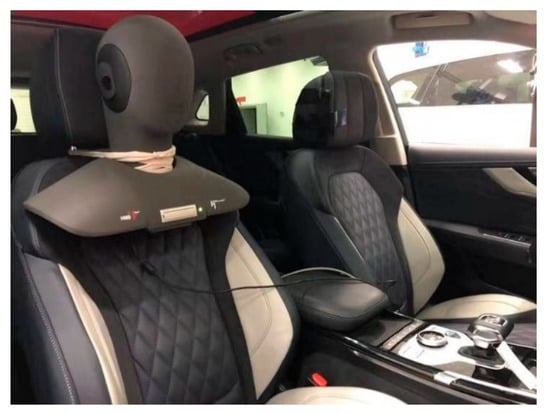
Figure 1.
Layout of sound measuring points in HEAD Acoustics artificial head.
Twelve FVs and two EVs were selected, and the sample vehicle information is shown in Table 4. Accelerated in-vehicle sound tests were carried out on the proving ground level and smooth road surface. The FVs adjusts the transmission gear to 3rd gear, the driver depresses the accelerator pedal until the accelerator is fully opened, and accelerates from the minimum engine speed corresponding to this gear to 6000 rpm at full load, simultaneously collecting the sound signal in the vehicle and the engine speed signal. The EV adjusts the transmission gear to D, depresses the accelerator pedal to 100% opening, accelerates the vehicle from the lowest stable speed to 120 km/h, and simultaneously collects the sound signal in the vehicle and the motor speed signal.

Table 4.
Basic information of test sample vehicle.
2.3. Subjective Evaluation Method of In-Vehicle Sound
The in-vehicle sound data of accelerated driving of 14 sample vehicles were imported into the sound playback and subjective evaluation system of HEAD Acoustics GmbH (Herzogenrath, Germany). The 14 samples were randomly numbered, the key information of the vehicle was hidden, and the subjective evaluation was scored only according to the sound samples.
2.3.1. Subjective Evaluation Result
The data with large deviations were excluded, and the average of the remaining subjective evaluation scores are shown in Table 5. The result distribution of a two-dimensional planar graph is shown in Figure 2.

Table 5.
Evaluation results of the sound samples in the accelerating vehicle.
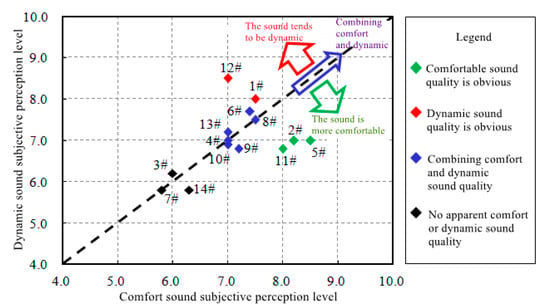
Figure 2.
Distribution of subjective evaluation results of sound quality in the sample vehicle when accelerating.
It can be seen from Figure 2 that the comfort quality characteristics on the right side are more obvious, the dynamic quality characteristics on the upper side are more obvious, and in the diagonal direction, the sound quality characteristics of both comfort and dynamic feeling in the upper right corner are more obvious.
2.3.2. Analysis of Subjective Evaluation Results
FFT spectral analysis of 14 sound samples tracking engine speed (or motor speed) is shown in Figure 3:

Figure 3.
FFT spectrum of sound in the vehicle of the sample vehicle during accelerated driving.
According to Figure 3:
- (1)
- No. 5#, 2#, and 11# vehicles have typical comfort accelerated driving interior sound. No. 5# vehicle has the lowest amplitude interior background sound, which can ensure high speech intelligibility. The ratio of engine order component sound energy to background sound energy is moderate. It has rich engine order components, and the engine order components below 400 Hz are clearer than those above 400 Hz, and there is a very obvious engine main order (order 3 or 4) component sound.
- (2)
- No. 12# and No. 1# vehicles have typical dynamic sense quality in accelerating driving interior sound, with very rich engine order components; The ratio of the engine order component sound energy to the background sound energy is slightly larger, that is, the engine order sound amplitude is more prominent. The engine order component above 400 Hz is clearer than that below 400 Hz. Especially for the 12# vehicle, the engine order component sound in the range of 450–500 Hz shows a relatively large level of enhancement, and the main order component sound amplitude of the engine is relatively moderate.
- (3)
- Other sample vehicles with both comfort and dynamic characteristics, such as 8# vehicle, also have rich engine order components led by the main engine order. The energy level of engine order components below 400 Hz is comparable to that of engine order components above 400 Hz, which is not as obvious as the sound quality characteristics of the above two types of sample vehicles.
2.4. Determination of Local Enhancement Area of Sound Amplitude in Vehicle Speed Range
According to the research on the driver’s dynamic driving behavior, the speed range in which the driver is most likely to accelerate the driving operation is summarized.
The speed range of 40–75 km/h is the range with the highest probability for the driver to accelerate, that is, the corresponding virtual engine speed range of 2500–4000 rpm is the first choice for improving the quality of in-vehicle dynamics through the ASGS.
2.5. Sound Control Needs for Comfort and Dynamic
This paper takes an A-class pure electric SUV as the research object, and the target sales group is positioned at fashionable young consumers. According to the results of the questionnaire survey, in order to take into account the perception requirements of two kinds of sound quality at the same time, the help of the ASGS in the vehicle is required to find a balance point, to achieve the sound quality characteristics of the A-class pure electric SUV with both comfort and dynamic sense.
Therefore, in this paper, the guiding principles of sound design in EVs under uniform speed are as follows: based on the subjective perception of human hearing, comprehensively consider the three dimensions of engine order composition, energy distribution in the frequency domain [35], and sound amplitude enhancement in the typical vehicle speed range [36], and carry out the uniform driving sound design of the ASGS in the EV.
3. In-Vehicle Engine Order Sound Fitting and Verification
3.1. In-Vehicle Sound Spectrum Analysis
In the accelerated driving condition, compared with the FV, the internal sound of EVs does not have the engine order component mainly characterized by low and medium frequencies, and at the same time, the motor order component and the reducer gear engagement order component with high frequencies appear. The typical in-vehicle sound spectrum comparison of the two models under accelerated driving conditions is shown in Figure 4.
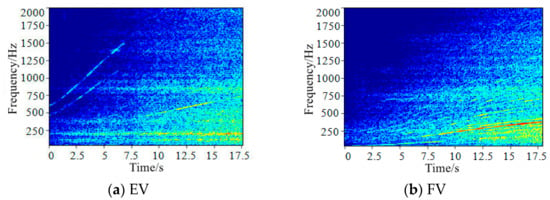
Figure 4.
Comparison of the sound spectrum in the vehicle under accelerated driving conditions.
Some literatures divide the engine sound into the engine order sound of the definite signal and the engine broadband sound of the random signal. The latter is very similar to the frequency characteristics of the road noise. This paper only focuses on the analysis of the engine order component sound.
The ignition excitation frequency of gasoline four-stroke engine can be summarized as the following formula [37]:
where is the engine speed, is the number of engine cylinders.
3.2. Engine Order Sound Synthesis Theory
3.2.1. Engine Order Sound Simulation Analysis
Text When the engine speed is , the engine 0.5 order component sound can be expressed by sine wave signal as follows:
where, is the sound of the 0.5 order component of the engine when the engine speed is , namely the instantaneous amplitude of the fundamental frequency (), is the 0.5 order component sound of the engine, namely the instantaneous phase of the fundamental frequency ().
The formula for calculating the kth harmonic frequency of the engine sound at this engine speed is:
The sound of the kth order component of the engine can be represented by a sine wave signal as:
The engine order sound in the vehicle can be expressed as follows:
where, is the kth engine order, that is, the instantaneous amplitude of the engine order component sound at the engine speed , is the kth engine order, that is, the instantaneous phase of the engine order component sound at the engine speed , is the effective number of engine order components.
In the time domain, the expression of the continuous time signal of the engine order component sound is:
where, is the kth engine order, that is, the amplitude of the engine component sound at time , is the kth engine order, namely the phase of the engine component sound at time , same as above.
The expression for the continuous-time signal of the in-vehicle engine order sound is:
3.2.2. Fourier Transform and Analysis of Sound Signal of Engine Order
Fast Fourier transform (FFT) is only suitable for stationary signal analysis. For the time-varying sound signal of the in-vehicle engine, an extended method of discrete Fourier transform, the short-time Fourier transform (STFT) method, needs to be used for analysis.
The mathematical expressions of discrete short-time Fourier transform and discrete short-time Fourier synthesis of discrete time signals are [38]:
where: is the serial number of the discrete time frame; is the serial number of discrete frequency frame; is the sampling period of time variable; is the sampling period of the frequency variable.
According to the principle of the Heisenberg uncertainty criterion of the short-time discrete Fourier analysis window function, the time resolution and the frequency resolution have a relationship: , it is impossible to obtain high-precision time resolution and frequency resolution.
3.2.3. Analysis and Selection of Window Function Characteristics
Commonly used window functions include rectangular window, Hanning window, Hamming window, Blackman window, Kaiser window, etc.
Key parameter indicators that affect the performance of window functions mainly include: main lobe width, side lobe peak value, and stopband minimum attenuation. The key parameter pairs of frequency response characteristics of each window function are shown in Table 6 [39].

Table 6.
Comparison of key parameters and indicators of common window functions.
In the process of increasing engine speed, the requirement of frequency resolution changes from high to low. At the same time, the higher the engine order frequency, the shorter the time period, and the faster the engine order frequency changes with time at high speed.
Kaiser window function has high flexibility, which can adjust the width of the main lobe and the peak value of the side lobe by controlling the shape parameter value and the window length , and is widely used in time-varying signal analysis in various engineering fields. The larger the value, the smaller the peak value of the side lobe and the larger the width of the main lobe. The larger the window length, the smaller the main lobe width, and the window length has no effect on the side lobe peak value. Eight typical Kaiser window functions with values are shown in Table 7.

Table 7.
Eight typical Kaiser window functions with values.
For the in-vehicle engine order sound, the calculation formula of the harmonic frequency difference between two adjacent engines is:
When the engine speed rises from 750 rpm to 6000 rpm, the fundamental frequency of the engine order sound is . When the main lobe width of Kaiser window function is , all engine order sound frequencies can be clearly identified.
The step length between adjacent frames also affects the results of short-time Fourier transform analysis. Usually, there is a certain overlap rate between adjacent frames, the step length of adjacent frames is less than the length of the frame itself, and the overlap rate is usually selected from 50% to 66.7%.
3.3. In-Vehicle Engine Order Sound Fitting
3.3.1. Test and Analysis of Engine Order Sound in FV
The following process was carried out: on the horizontal smooth asphalt pavement in a test field, shift the transmission gear to the third gear, and slowly press the accelerator pedal to accelerate the engine speed from the lowest engine speed in the gear to the rated engine speed. The entire acceleration time is not less than 20 s, and the sampling frequency is set to 51.2 kHz. The time-domain signal and FFT spectrum analysis of the sound in FVs under acceleration driving obtained from the test are shown in Figure 5 and Figure 6.
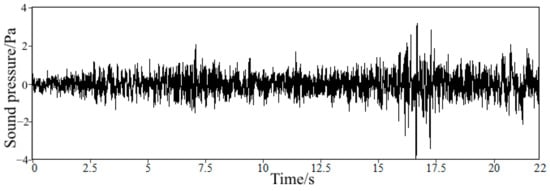
Figure 5.
Acoustic time-domain signal in an FV accelerating.
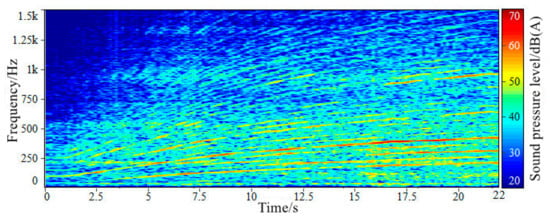
Figure 6.
Sound spectrum inside an FV accelerating.
3.3.2. In-Vehicle Engine Order Sound Synthesis and Verification
Short-time Fourier transform is then performed on the engine order components in Figure 6. The main parameters are set as: analysis window Kaiser window, is 5.8, window length is 1280, FFT length is 4096, overlap rate is 50%, and time frame length is 0.05 s. Through short-time Fourier synthesis, the sound fitting of the in-vehicle engine order components is completed. The synthesized sound time domain signal and FFT spectrum of the accelerated driving vehicle are shown in Figure 7 and Figure 8.
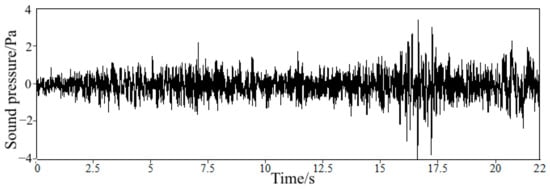
Figure 7.
Synthesized time-domain signal of in-vehicle sound when accelerating.
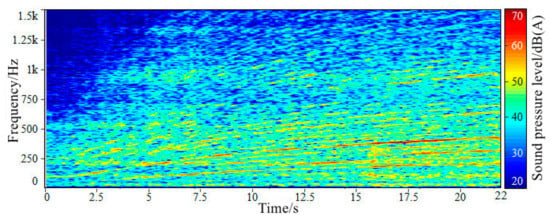
Figure 8.
Synthesized sound spectrum of accelerating vehicle.
According to Figure 5, Figure 6, Figure 7 and Figure 8, the variation law of the main energy area and main order component amplitude of the synthesized sound spectrum in the accelerated driving vehicle is not much different from the original input signal, but slightly different in the low-speed area and the high order sub area. There is a certain degree of discontinuity in the amplitude changes of these order components.
It Is confirmed by subjective listening that there is little difference between the two in the overall subjective auditory perception, and there is a slight difference between the synthesized sound and the original sound signal in the sense of sound reality, which is mainly caused by the error of engine order component synthesis in the high frequency region.
Therefore, the short-time Fourier transform and synthesis technology based on the Kaiser window function can meet the fitting accuracy requirements of the engine order sound, and can be used for the engine sound simulation of the ASGS in the vehicle.
4. Study on Active Sound Control Method under Constant Speed Condition
4.1. Sound Design Plan under Constant Speed Condition
The principles of sound design under constant speed conditions are: the overall comfort should be reflected; and the dynamic feeling should be reflected in the local speed range.
Determine specific sound design requirements:
- (1)
- Establishing an order structure in which the 4th order of the engine is dominant and the integer order and half-order of other engines are supplementary, with the main engine order sound amplitude being moderate and the engine order components covering the 20–1200 Hz range.
- (2)
- The sound amplitude of the engine order components below 400 Hz should be greater than that above 400 Hz.
- (3)
- The sound amplitude of engine order components in the virtual engine speed interval of 2500–4000 rpm should be appropriately enhanced, and the overall trend should be gradually increasing with the engine speed.
The Active Sound Design module of Genesis acoustic processing software LEA was used to construct the sound of the engine order components, and the sound amplitude gain plan was developed for the virtual engine speed interval of 2500–4000 rpm. The variation curve of the total sound value of the plan with the engine speed is shown in Figure 9.
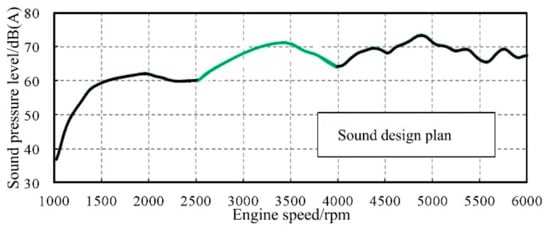
Figure 9.
Design plan of in-vehicle sound at different speeds.
The evaluation team was organized to conduct subjective evaluation of the plan, and the result was shown in Figure 10.
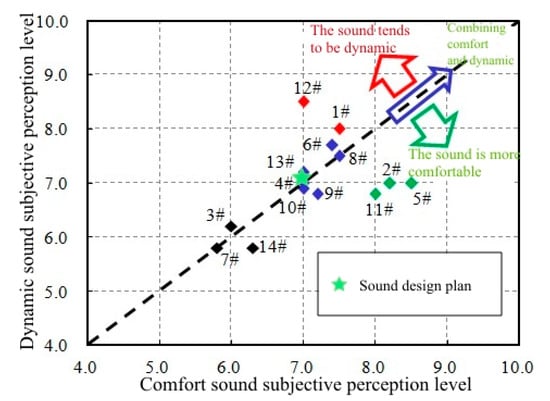
Figure 10.
Distribution of subjective evaluation results of the plan.
According to the subjective evaluation results, it can be seen that the sound in the vehicle can have both comfort and dynamic feeling under different speed conditions. This plan is selected for the ASGS in the EV.
4.2. Uniform Driving Conditions Sound Total Value Target Setting
The target setting of the total sound value of the ASGS under the condition of constant speed driving is carried out according to the 3rd gear driving condition of the target FV. According to the engine speed of 1000–6000 rpm in the operating condition, the sound inside the vehicle of the FV in the 3rd gear running at a uniform speed was tested. The engine order sound and the background sound in the vehicle were separated, and the total value of the vehicle sound, the total value of the engine order sound, the total value of the background sound, and the sound pressure level difference between the engine order sound and the background sound were calculated at a constant speed, as shown in Table 8 and Figure 11. The change curve of sound pressure level difference between engine order sound and background sound in the vehicle is shown in Figure 12.

Table 8.
Test results of in-vehicle sound of the target FV at constant speed.
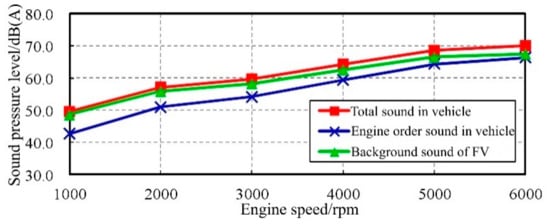
Figure 11.
Comparison of sound and noise results in the FV under constant speed driving conditions.
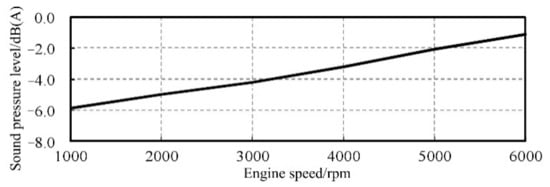
Figure 12.
The variation curve of the difference between the engine order sound and the background sound of the FV driving at a constant speed.
- (1)
- With the increase of engine speed, the amplitude of engine order sound and the amplitude of background sound show a linear increase trend, and the increase of engine order sound amplitude is greater than that of background sound amplitude.
- (2)
- With the increase of engine speed, the difference between engine order sound and background sound tends to decrease linearly.
For an A-class pure electric SUV studied in this paper, the vehicle speed corresponding to each virtual engine speed was calculated, and the amplitude of the sound inside the vehicle at each speed is tested and calculated, as shown in Table 9. It is further compared with the background sound inside the FV, as shown in Figure 13.

Table 9.
Test results of in-vehicle sound of EVs driving at a constant speed.
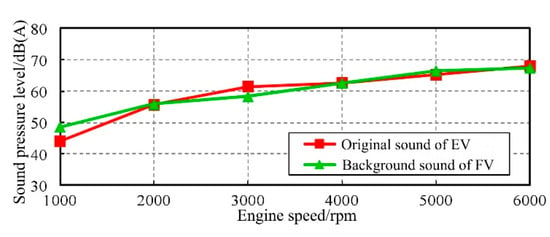
Figure 13.
Comparison of the results of the total sound value of the EV driving at a constant speed.
According to the amplitude relationship between the engine order sound and the background sound of the FV in Figure 12, on the basis of the original internal sound of the EV, the target setting of the sound amplitude and the total value of the internal sound of the ASGS in the uniform driving condition is carried out, as shown in Table 10 and Figure 14.

Table 10.
The total sound value of the EV driving at a constant speed and the target setting of the sound amplitude of the ASGS.
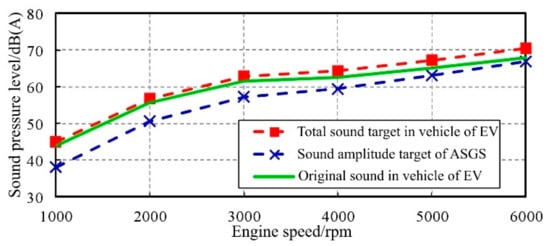
Figure 14.
Total value of sound inside EV and sound amplitude target of ASGS.
The sound amplitude target line of the ASGS under uniform driving conditions is the blue dashed line in Figure 14. It is required that the sound produced by the system should not exceed the target curve to ensure the low amplitude noise level in the EV under uniform driving condition, so as to meet the requirements of comfort sound quality control.
4.3. ASGS Control Method
In order to achieve the sound control requirements of comfort and dynamic, and considering the difficulty of programming the control parameters and the operability in actual control, the vehicle speed and accelerator pedal opening are used as the sound control parameters of the ASGS.
The steps of engine order components extraction are as follows: First, the test data of vehicle sound signal and engine speed signal are imported into the software for FFT analysis, and the vehicle spectrum cloud image tracking engine speed is obtained. Then, the automatic extraction function is used to set the order parameters of the engine order, and the desired engine order is automatically identified and selected. Finally, through the separation function, the unselected sound components are deleted, and the identified engine order components are retained to realize the extraction of engine order components.
Through this method, the engine order components are extracted for the sound in the vehicle when accelerating with 40% accelerator pedal opening, and the results are shown in Figure 15.
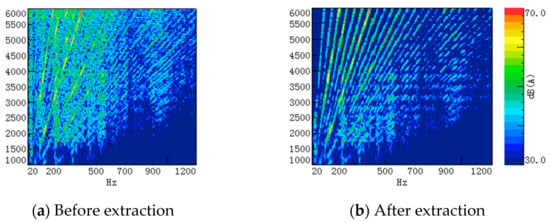
Figure 15.
Comparison of the sound spectrum in the vehicle before and after the extraction of engine order components.
It can be seen from Figure 15 that this method can be used to extract the order components of the engine in the vehicle under accelerated driving conditions, and can basically restore the original vehicle state well.
The changes of engine order sound amplitude in all working conditions with the trend of engine speed are summarized, as shown in Figure 16.

Figure 16.
Summary of variation trend of engine order sound amplitude in all working conditions.
It can be seen from Figure 16 that the speed range of 1000–1800 rpm is the initial rapid change area of amplitude, the speed range of 1800–3000 rpm is the smooth transition area of amplitude, and the speed range of 3000–6000 rpm is the area of stable amplitude growth.
The speed range of 3000–6000 rpm is taken as the preferred range for the correlation analysis between sound amplitude and engine output power. The trend of the in-vehicle engine order sound amplitude trend with the accelerator pedal opening is shown in Figure 17, and the change curve with the engine output power load ratio is shown in Figure 18.
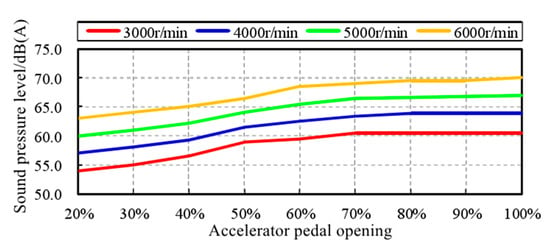
Figure 17.
The trend of the order sound amplitude of the in-vehicle engine varies with the accelerator pedal opening.
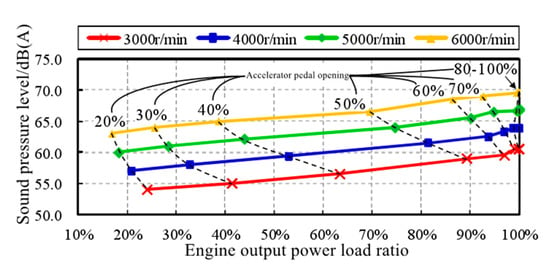
Figure 18.
Trend of in-vehicle engine order sound amplitude changes with engine output power load ratio.
The mean value of the sound amplitude gain coefficient is calculated according to Figure 18, as shown in Table 11. Apply it to the full power output load ratio of the engine, and draw the change curve of the in-vehicle engine order sound amplitude gain with the engine output power load ratio, as shown in Figure 19.

Table 11.
Calculation of sound amplitude gain coefficient.
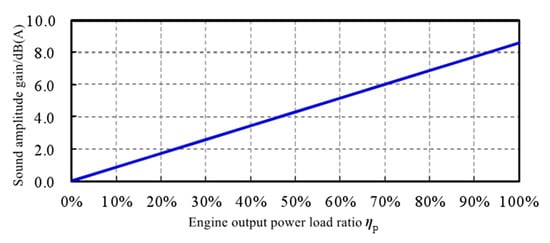
Figure 19.
Change curve of in-vehicle engine order sound amplitude gain with engine output power load ratio.
4.4. Analysis on Parameter Setting of ASGS of EV
Under different accelerator pedal openings, the electric vehicle motor speed, motor torque, and other parameters were tested, and the test preparation was similar to that described above. Test conditions: the transmission gear is set to D gear, the driver quickly depresses the accelerator pedal and keeps it at 20% opening, the motor speed is accelerated from 0 rpm to 6000 rpm, and the parameter information is collected and recorded synchronously. Complete the above test process respectively at 30~100% accelerator pedal opening.
The time history curve of In-vehicle test results at 60% accelerator pedal opening is shown in Figure 20.
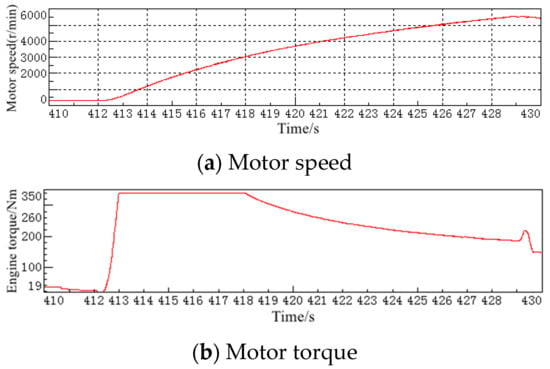
Figure 20.
Time history curve of test signal at 60% accelerator pedal opening.
According to the test results of motor torque and speed, the motor output power under constant accelerator pedal opening is calculated. The variation curve of motor output power with motor speed is shown in Figure 21, and the variation curve of motor output power with accelerator pedal opening at different speeds is shown in Figure 22.
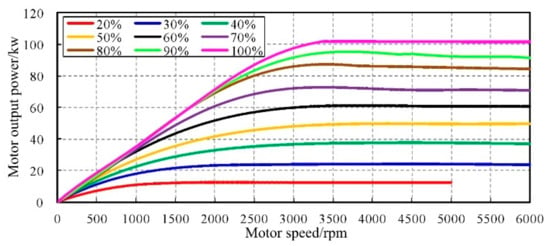
Figure 21.
The curve of motor output power with motor speed under different accelerator pedal openings.
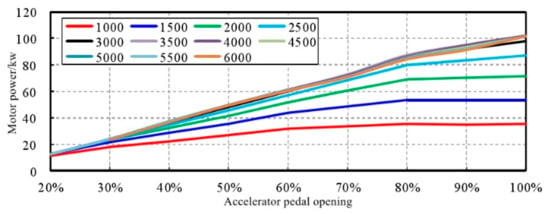
Figure 22.
The curve of the motor output power with the accelerator pedal opening under different motor speeds.
According to Figure 21, as the motor speed increases, the motor output power shows a linear increase trend, and tends to a stable value after reaching a certain motor speed, which is consistent with the typical motor output power characteristic curve.
According to Figure 22, with the linear increase of accelerator pedal opening, when the motor speed is greater than 3000 rpm, the motor output power shows a linear increase trend. When the motor speed is in the range of 1500–3000 rpm, the motor output power is still linearly related to the accelerator pedal opening within the range of no more than 80%. When the motor speed is less than 1500 rpm, the motor output power is linear with the increase of the accelerator pedal opening within the range of no more than 60%.
The control strategy of sound amplitude gain with accelerator pedal opening is formulated as shown in Figure 23: sound amplitude gain coefficient .
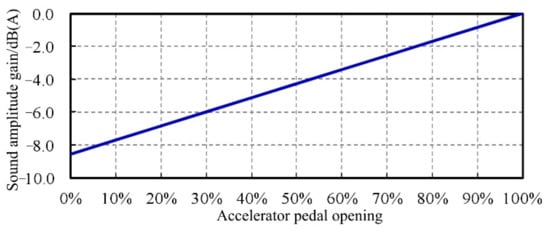
Figure 23.
Control curve of sound amplitude gain with accelerator pedal opening.
When the engine speed is less than 1800 rpm, the amplitude of the engine order sound starts to increase rapidly from a relatively low amplitude in each accelerator pedal opening of the FV. When the engine speed is greater than 1800 rpm, the sound amplitude shows a steady increasing trend.
The control curve of sound amplitude gain with vehicle speed is formulated as shown in Figure 24. Among them, the minimum sound amplitude gain corresponding to 0 km/h needs to be adjusted according to the subjective audition effect on the real vehicle, so as to meet the needs of comfortable acceleration driving in-vehicle sound.
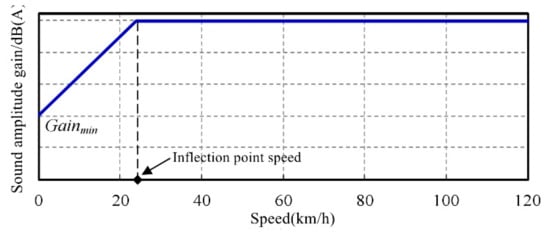
Figure 24.
Control curve of sound amplitude gain with vehicle speed.
5. Development of ASGS for the EV
5.1. Hardware Development of Vehicle ASGS
The control system reads the vehicle speed, engine speed (or motor speed), accelerator pedal opening, gear, and other information in real time from the vehicle CAN information. Combined with the pre-designed sound parameter file, the control system carries out real-time operations to synthesize the corresponding sound signal under the current working condition, and outputs it to the vehicle audio system through the power amplifier. The schematic diagram of the ASGS in the vehicle is shown in Figure 25.
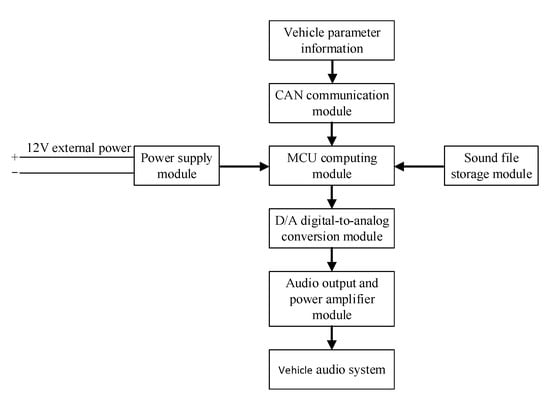
Figure 25.
Schematic diagram of active sound control system in the vehicle.
The main chip and each module are assembled into a complete controller physical object as shown in Figure 26.
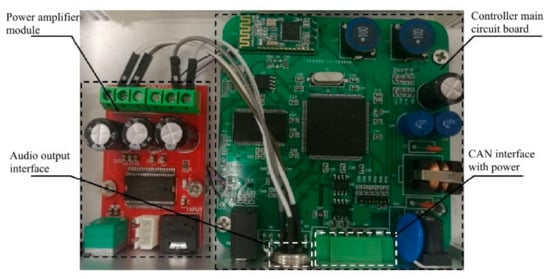
Figure 26.
Physical picture of active sound controller in vehicle.
5.2. Software Design of Vehicle ASGS
C language was used to write the software of the ASGS in the vehicle, and the software program was modularized. The workflow is shown in Figure 27.
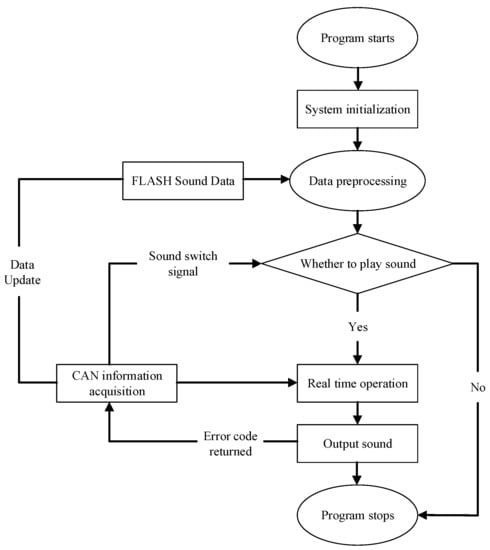
Figure 27.
Flowchart of ASGS program.
5.3. Construction of ASGS
Power amplifier: The power amplifier of the sound system is arranged in the trunk and connected to six speakers through a wire harness.
Speaker: the low-frequency speaker is arranged in the lower right corner of the left front door and the lower left corner of the right front door; the full frequency speaker is arranged in the lower right corner of the left rear door and the lower left corner of the right rear door; the high-frequency speakers are arranged at the joint positions between the left and right A-pillars and the instrument panel, as shown in Figure 28, Figure 29 and Figure 30.
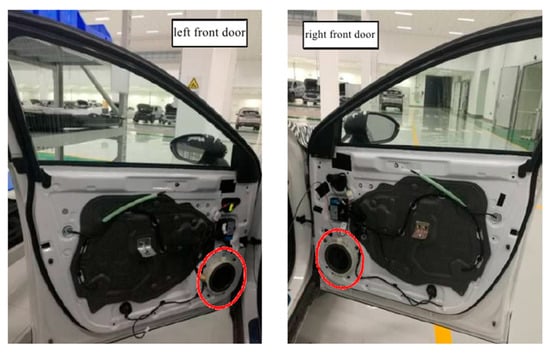
Figure 28.
Layout of mid-low frequency speakers.
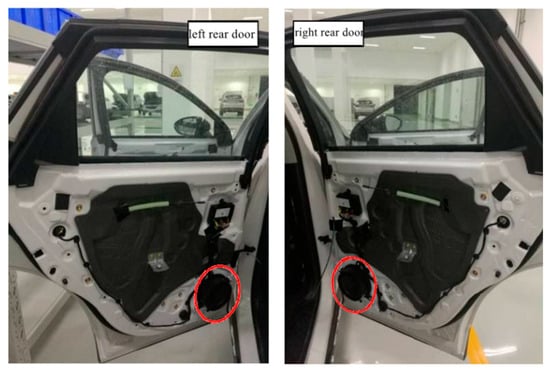
Figure 29.
Layout of full frequency speakers.
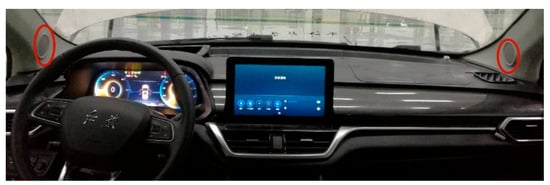
Figure 30.
Layout of high-frequency speakers.
The sound output line of the ASGS is connected to the power amplifier harness of the sound system, and the ASGS in the vehicle is shown in Figure 31.
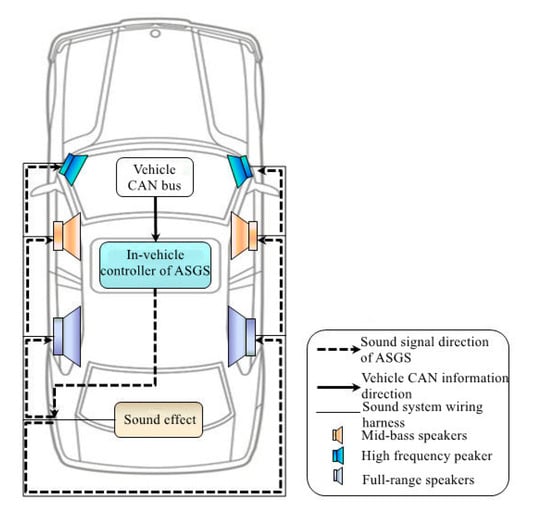
Figure 31.
Schematic diagram of the in-vehicle ASGS based on the original audio system speaker of an EV.
5.4. Sound Calibration of ASGS under High Fidelity Speaker Condition
In the semi-anechoic chamber environment of the vehicle, a GENELEC 8030B dual-power amplifier active speaker is used as a high-fidelity speaker, and a B&K1890A ICP microphone was arranged at a position 0.1 m away from the speaker surface to carry out the frequency response test.
The measured time domain signal is shown in Figure 32, the FFT spectrum is shown in Figure 33, and the FFT spectrum of the original white noise signal is shown in Figure 34.
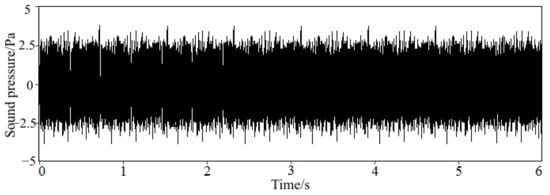
Figure 32.
Time-domain signal of high-fidelity speaker sound test.
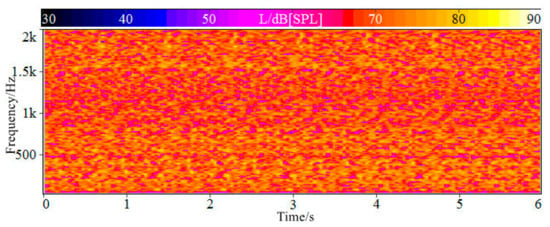
Figure 33.
FFT spectrum of high-fidelity speaker test.
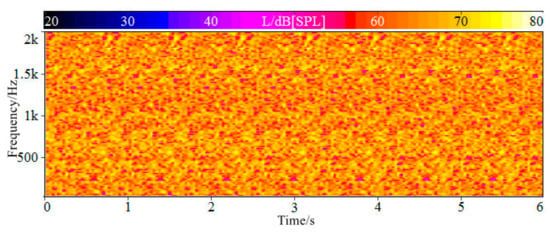
Figure 34.
FFT spectrum of the original white noise signal.
Comparing Figure 33 and Figure 34, the frequency response of the speaker in the range of 20–2000 Hz is almost the same as that of the original white noise signal, with only a certain difference in sound amplitude, which is related to the position of the amplitude adjustment knob and the position of the measuring point of the sound system. It shows that the speaker can truly reflect the engine order sound frequency characteristics synthesized by the ASGS in the frequency range of 20–2000 Hz.
Subjective evaluation audition of the engine sound in the two states has good consistency. The sound synthesized by the ASGS can truly restore the spectral characteristics of the design state. Therefore, the engine sound fitting accuracy of the ASGS can meet the system design requirements.
6. In-Vehicle Sound Test and Analysis of EV ASGS
6.1. Objective Testing and Evaluation
One tester was arranged to sit in the driving position, and the all-pointing microphone 4189-A-021 made by B&K (Nairum, Denmark) was arranged near the right ear of the driver. Reference “GB/T18697-2002 acoustic vehicle interior noise measurement method” layout method is used, access Siemens SCR205 multi-channel data acquisition front end, record microphone acquisition sound signal, and always close all doors and windows in the test process. The in-vehicle photo of the scene is shown in Figure 35.
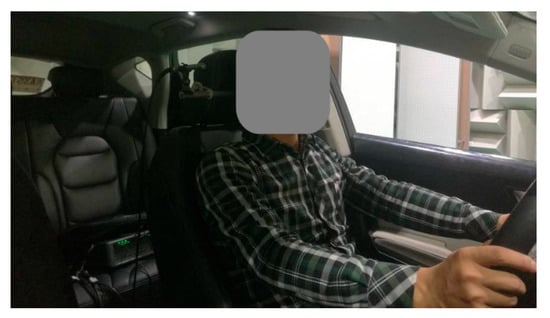
Figure 35.
Field in-vehicle test attempt.
Test the sound signals inside the vehicle of the ASGS under the virtual engine speed of 1000–6000 rpm and the test time of each working condition is not less than 10 s. Then, calculate the total value of sound pressure level, loudness, sharpness, and roughness of the vehicle under the working and non-working conditions of the ASGS. For example, see Table 12, Table 13, Table 14, Table 15 and Figure 36, Figure 37, Figure 38 and Figure 39.

Table 12.
Calculation results of sound pressure level in the vehicle traveling at a constant speed.

Table 13.
Calculation results of sound loudness in the vehicle traveling at a constant speed.

Table 14.
Calculation results of sound sharpness in the vehicle traveling at a constant speed.

Table 15.
Calculation results of sound roughness in the vehicle traveling at a constant speed.
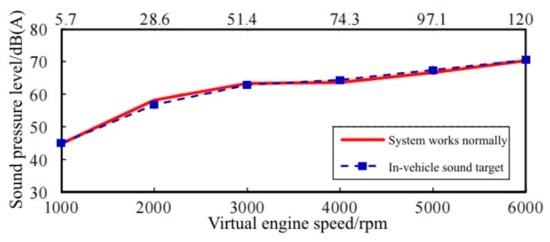
Figure 36.
Comparison of the calculation results of sound pressure level in the vehicle driving at a constant speed.
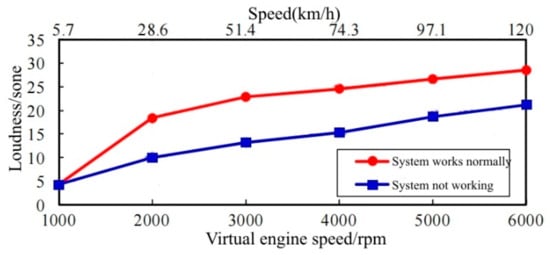
Figure 37.
Comparison of the calculation results of the sound loudness in the vehicle driving at a constant speed.
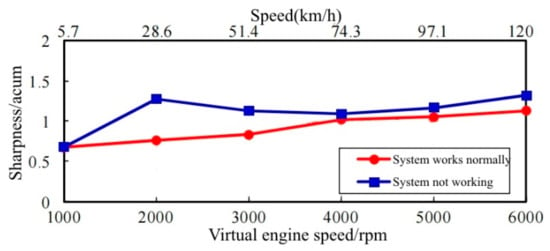
Figure 38.
Comparison of the calculation results of sound sharpness in the vehicle driving at a constant speed.
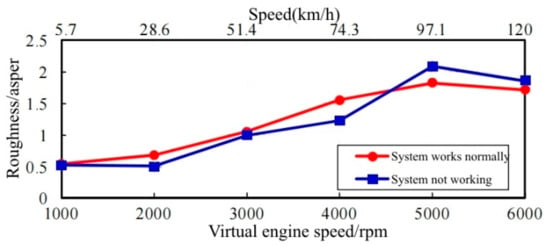
Figure 39.
Comparison of the calculation results of the sound roughness in the vehicle driving at a constant speed.
According to the comparison of the above results, we can get:
- (1)
- When the ASGS works normally, the calculated results of the sound pressure level of the vehicle under each speed are basically consistent with the target value, which ensures the low amplitude of the vehicle noise level, so as to meet the comfort quality target requirements of the vehicle under the uniform speed.
- (2)
- The changes of sound pressure level, loudness, sharpness, and roughness under uniform driving conditions are similar to those under accelerated driving conditions. When the system is working normally, the calculated results of sound pressure level and loudness are larger than those of the original vehicle, while the sharpness is smaller than that of the original vehicle. When the vehicle speed is 28.6 km/h (the virtual engine speed is 2000 rpm), the sharpness decreases by 0.52 acum. At the same time, the roughness is not different from the original vehicle.
6.2. Real Vehicle Subjective Evaluation
Subjective evaluation was made on the interior sound of the EV and the target coupe-type FV in the driving state.
Evaluation of the sample vehicle and state: the original vehicle state of the PEV, the normal working state of the ASGS, and the original vehicle state of a coupe-type FV.
Evaluation of operating conditions: The uniform driving test was carried out in the 0–120 km/h speed range of asphalt smooth road in the test site of a large automobile R&D center.
The final evaluation results of the three sample vehicles are shown in Table 16, and the distribution of sound quality perception is shown in Figure 40.

Table 16.
Subjective evaluation score record of real vehicle at constant speed.
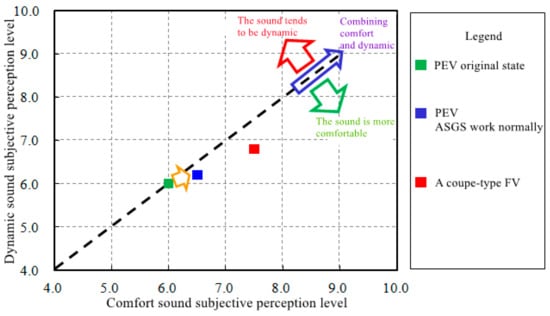
Figure 40.
Sound quality distribution of three sample vehicles under uniform driving conditions.
Based on the analysis of subjective evaluation and objective test results, it can be concluded that:
The sound produced by the ASGS of EVs at uniform speed increases the amplitude and loudness of the sound inside the vehicle, and improves the sharpness to a certain extent. At the same time, the amplitude of the sound produced by the system at uniform speed is moderate, which improves the comfort and dynamic quality of the sound inside the vehicle at uniform speed.
Therefore, the EV ASGS achieves the concept design goal of “both comfort and dynamic sense sound quality characteristics”.
7. Conclusions
- (1)
- The development trend of EV in-vehicle sound has been investigated and researched, and the concept design goal of in-vehicle sound with “both comfort and dynamic sense sound quality characteristics” has been formulated. Combined with the subjective evaluation method and test results, a sound design method is proposed for the vehicle under uniform speed, which mainly considers three dimensions of engine order composition, spectral energy distribution, and sound amplitude enhancement in typical speed range.
- (2)
- The in-vehicle sound spectrum of the FV is analyzed, and the sound simulation analysis of the engine order is completed. The short-time Fourier transform (STFT) is used to synthesize the engine order sound in the vehicle, and it is verified that the STFT and synthesis technology based on Kaiser window function can meet the fitting accuracy of the engine order sound, and can be used to simulate the starting sound of the ASGS in the vehicle.
- (3)
- The sound design plan and control target of an A-class pure electric SUV under uniform speed conditions with both comfort and dynamic sense are formulated. A sound amplitude control method of active sound system is proposed based on the variation law of engine order sound amplitude and engine output power of traditional internal combustion engine vehicle. The correlation between engine order sound amplitude and dynamic sense is analyzed, and the parameter setting of EV active sound is clarified.
- (4)
- The hardware of the in-vehicle ASGS is designed, the control software of the in-vehicle ASGS is developed, the construction of the EV ASGS based on the speaker of the in-vehicle sound system is completed, and the ASGS is tested and verified.
- (5)
- When the ASGS works normally, the noise level of low amplitude is guaranteed. When the vehicle speed is 28.6 km/h, the sharpness is reduced by 0.52 acum. Combined with objective evaluation test and subjective evaluation test of a real vehicle, it is verified that the ASGS in this paper can improve the comfort and dynamic sense quality characteristics of EVs in uniform driving conditions.
Author Contributions
Conceptualization, S.Z., Y.L. and Y.C.; methodology, S.Z. and Y.L.; software, S.Z., Y.L. and Y.C.; validation, S.Z. and Y.L.; formal analysis, S.Z., Y.L. and Y.C.; writing—original draft preparation, S.Z. and Y.L.; writing—review and editing, S.Z., Y.L. and L.X.; visualization, Y.L.; supervision, S.Z., Y.L. and L.X.; project administration, S.Z. and L.X.; funding acquisition, S.Z. and L.X. All authors have read and agreed to the published version of the manuscript.
Funding
This research was funded by the Major Science and Technology Project of Henan Province (221100240400), Key Scientific Research Project of Colleges and Universities in Henan Province (no. 20A460013) and the National Key Research and Development Program of China (no. 2017YFD070020402).
Data Availability Statement
Not applicable.
Conflicts of Interest
The authors declare no conflict of interest.
References
- Hee, L.K.; Kwon, L.S.; Kim, K. Objective Evaluation of Whine Noise of Electric Vehicle according to the Characteristics of Sound-absorbing Materials. Trans. Korean Soc. Noise Vib. Eng. 2017, 27, 829–835. [Google Scholar] [CrossRef]
- Wagner-Hartl, V.; Graf, B.; Resch, M.; Langjahr, P. Subjective Evaluation of EV Sounds: A Human-Centered Approach. In Proceedings of the 1st International Conference on Human Systems Engineering and Design: Future Trends and Applications, Munich, Germany, 16–18 September 2012; Volume 876, pp. 10–15. [Google Scholar] [CrossRef]
- Doleschal, F.; Verhey, J.L. Pleasantness and magnitude of tonal content of electric vehicle interior sounds containing subharmonics. Appl. Acoust. 2022, 185, 108442. [Google Scholar] [CrossRef]
- Lee, S.K.; Lee, G.H.; Back, J. Development of sound-quality indexes in a car cabin owing to the acoustic characteristics of absorption materials. Appl. Acoust. 2019, 143, 125–140. [Google Scholar] [CrossRef]
- Park, J.H.; Park, H.; Kang, Y.J. A study on sound quality of vehicle engine sportiness using factor analysis. J. Mech. Sci. Technol. 2020, 34, 3533–3543. [Google Scholar] [CrossRef]
- Wang, D.F.; Tan, G.P.; Chen, S.M.; Jiang, J.G.; Su, L.L. Research on Speech Intelligibility of Sound Field inside Passenger Car. In Proceedings of the 7th International Conference on MEMS, NANO and Smart Systems (ICMENS 2011), Shangsha, China, 14–15 December 2012; pp. 5214–5219. [Google Scholar] [CrossRef]
- Qian, K.; Hou, Z.C.; SUN, D.K. Sound Quality Estimation of Electric Vehicles Based on GA-BP Artificial Neural Networks. Appl. Sci. 2020, 10, 5567. [Google Scholar] [CrossRef]
- Fang, Y.; Chen, H.C.; Zhang, T. Contribution of acoustic harmonics to sound quality of pure electric powertrains. Iet Electr. Power Appl. 2018, 12, 808–814. [Google Scholar] [CrossRef]
- Ma, C.G.; Li, Q.; Deng, L.W.; Chen, C.Y.; Liu, Q.H.; Gao, H.B. A Novel Sound Quality Evaluation Method of the Diagnosis of Abnormal Noise in Interior Permanent-Magnet Synchronous Motors for Electric Vehicles. IEEE Trans. Ind. Electron 2017, 64, 3883–3891. [Google Scholar] [CrossRef]
- Min, D.; Park, B.; Park, J. Artificial Engine Sound Synthesis Method for Modification of the Acoustic Characteristics of Electric Vehicles. Shock Vib. 2018, 2018, 5209207. [Google Scholar] [CrossRef]
- Swart, D.J.; Bekker, A.; Bienert, J. The subjective dimensions of sound quality of standard production electric vehicles. Appl. Acoust. 2018, 129, 354–364. [Google Scholar] [CrossRef]
- Seo, J.H.; Choi, I.; Chon, S.B.; Sung, K.M. An Improved Method for Objective Quality Assessment of Multichannel Audio Codecs. Ieice Trans. Fundam. Electron. Commun. Comput. Sci. 2011, E94A, 1747–1752. [Google Scholar] [CrossRef]
- Lee, S.M.; Back, J.; An, K.; Lee, S.K. Design and Generation of a Target Sound to Achieve the Desired Sound Quality Inside a Car Cabin. Int. J. Automot. Technol. 2020, 21, 385–395. [Google Scholar] [CrossRef]
- Gao, Y.H.; Xie, J.; Liang, J.; Chang, X.; Wu, B.J. A Sound Quality Objective Evaluation Method Based on Auditory Peripheral Simulation Model. J. Bionic Eng. 2010, 7, 199–208. [Google Scholar] [CrossRef]
- Bernardi, G.; van Waterschoot, T.; Wouters, J.; Moonen, M. Subjective and Objective Sound-Quality Evaluation of Adaptive Feedback Cancellation Algorithms. IEEE-ACM Trans. Audio Speech Lang. Process. 2018, 26, 1010–1024. [Google Scholar] [CrossRef]
- Wang, Z.H.; Li, P.H.; Liu, H.G.; Yang, J.H.; Liu, S.Y.; Xue, L. Objective sound quality evaluation for the vehicle interior noise based on responses of the basilar membrane in the human ear. Appl. Acoust. 2021, 172, 107619. [Google Scholar] [CrossRef]
- Thilagam, S.; Karthigaikumar, P. Implementation of Interior Noise Control System Using Digital Adaptive Filter for On-Road Car Applications. Wirel. Pers. Commun. 2019, 104, 339–356. [Google Scholar] [CrossRef]
- Liang, K.; Zhao, H.J. Automatic Evaluation of Internal Combustion Engine Noise Based on an Auditory Model. Shock Vib. 2019, 2019, 2898219. [Google Scholar] [CrossRef]
- Zhang, E.L.; Hou, L.; Shen, C.; Shi, Y.L.; Zhang, Y.X. Sound quality prediction of vehicle interior noise and mathematical modeling using a back propagation neural network (BPNN) based on particle swarm optimization (PSO). Meas. Sci. Technol. 2016, 27, 015801. [Google Scholar] [CrossRef]
- Lu, Y.; Zuo, Y.Y.; Wang, H.; Wu, C.G. Sound quality prediction for power coupling mechanism of HEV based on CEEMD-HT and RVM. Neural Comput. Appl. 2020, 33, 8201–8216. [Google Scholar] [CrossRef]
- Lee, H.; Park, Y. Adaptive Algorithm of Active Sound Design for the Engine Noise. In Proceedings of the 12th Asian Control Conference (ASCC), Kitakyushu, Japan, 9–12 June 2019; pp. 343–347. [Google Scholar]
- Liu, F.; Mills, J.K.; Dong, M.M.; Gu, L. Active broadband sound quality control algorithm with accurate predefined sound pressure level. Appl. Acoust. 2017, 119, 78–87. [Google Scholar] [CrossRef]
- Liu, N.N.; Sun, Y.D.; Wang, Y.S.; Guo, H. Active control for vehicle interior noise using the improved iterative variable step-size and variable tap-length LMS algorithms. Noise Control Eng. J. 2019, 67, 405–414. [Google Scholar] [CrossRef]
- Wang, Y.S.; Feng, T.P.; Wang, X.L.; Guo, H.; Qi, H.Z. An improved LMS algorithm for active sound-quality control of vehicle interior noise based on auditory masking effect. Mech. Syst. Signal Process. 2018, 108, 292–303. [Google Scholar] [CrossRef]
- Chen, W.; Lu, C.H.; Liu, Z.E.; Williams, H.; Xie, L.P. A computationally efficient active sound quality control algorithm using local secondary-path estimation for vehicle interior noise. Mech. Syst. Signal Process. 2022, 168, 108698. [Google Scholar] [CrossRef]
- Kato, T.; Kitamura, T.; Maehara, F.; Nakayama, H. Development wall surface speaker for ultra-compact EV. In Proceedings of the 24th International Conference on Electrical Machines and Systems (ICEMS), Gyeongju, Korea, 31 October–3 November 2021; pp. 840–843. [Google Scholar] [CrossRef]
- Ghanati, G.; Azadi, S. Active control of vehicle’s interior sound field by using multichannel H-infinity robust controller. Proc. Inst. Mech. Eng. Part D-J. Automob. Eng. 2020, 234, 725–738. [Google Scholar] [CrossRef]
- Ryu, S.; Lee, Y.S.; Kim, S. Active Control of Engine Sound Quality in a Passenger Car Using a Virtual Error Microphone. Int. J. Parallel Program. 2020, 48, 909–927. [Google Scholar] [CrossRef]
- Zhang, X.J. The Co-Pilot Position of Vehicle Noise Quality Prediction Based on SVM. In Proceedings of the 7th International Conference on Material Science and Environmental Engineering (MSEE), Wuhan, China, 15–16 November 2020; Volume 735, p. 012064. [Google Scholar] [CrossRef]
- Lee, J.K.; Park, Y.W.; Chai, J.B.; Jang, H.K. Development of a sound quality index for the evaluation of booming noise of a passenger car based on regressive correlation. Int. J. Automot. Technol. 2005, 6, 367–374. [Google Scholar]
- Feng, T.; Sun, G.H.; Xu, J.; Li, M.F.; Lim, T.C. Frequency domain inverse model lms algorithm for active sound tuning system of powertrain noise. In Proceedings of the 22nd International Congress on Sound and Vibration (ICSV), Florence, Italy, 12–16 July 2015. [Google Scholar]
- Yu, W.T. Analysis and Optimization of Low-Speed Road Noise in Electric Vehicles. Wirel. Commun. Mob. Comput. 2021, 2021, 5537704. [Google Scholar] [CrossRef]
- Hiscutt, P.; Ishikawa, S. Development of Exhaust Sound Quality on Aston Martin V8 Vantage. SAE Int. J. Passeng. Cars-Mech. Syst. 2008, 1, 792–800. [Google Scholar] [CrossRef]
- Arvanitis, A.; Orzechowski, F.; Tousignant, T. Automobile Powertrain Sound Quality Development Using a Design for Six Sigma (DFSS) Approach. SAE Int. J. Passeng. Cars-Mech. Syst. 2015, 8, 1110–1119. [Google Scholar] [CrossRef]
- Brandl, F.; Biermayer, W.; Pfluer, M. Objective assessment of vehicle interior noise quality. Sound Vib. 1999, 33, 20. [Google Scholar]
- Kim, S.; Chang, K.; Park, D. A Systematic Approach to Engine Sound Design for Enhancing Sound Character by Active Sound Design. SAE Int. J. Passeng. Cars-Mech. Syst. 2015, 10, 691–702. [Google Scholar] [CrossRef]
- Siano, D.; Panza, M.A. Sound quality analysis of the powertrain booming noise in a Diesel passenger car. Energy Procedia 2018, 126, 971–978. [Google Scholar] [CrossRef]
- Kamalakkannan, R.; Roopkumar, R.; Zayed, A. Short time coupled fractional fourier transform and the uncertainty principle. Fract. Calc. Appl. Anal. 2021, 24, 667–688. [Google Scholar] [CrossRef]
- Lai, Z.; Xiao, Z.; Zhang, G.; Wang, G. Application of FFT Interpolation Correction Algorithm Based on Window Function in Power Harmonic Analysis. In Proceedings of the 4th International Conference on Environmental Science and Material Application (ESMA 2018), Xi’an, China, 15–16 December 2018; Volume 252, p. 032184. [Google Scholar] [CrossRef]
Publisher’s Note: MDPI stays neutral with regard to jurisdictional claims in published maps and institutional affiliations. |
© 2022 by the authors. Licensee MDPI, Basel, Switzerland. This article is an open access article distributed under the terms and conditions of the Creative Commons Attribution (CC BY) license (https://creativecommons.org/licenses/by/4.0/).